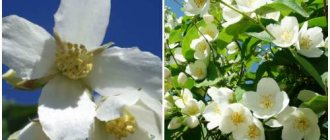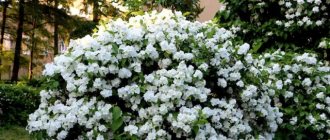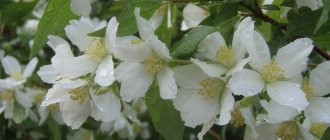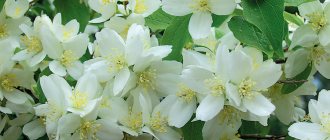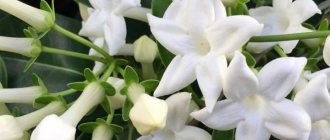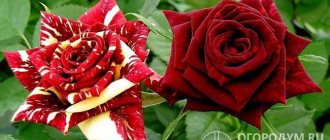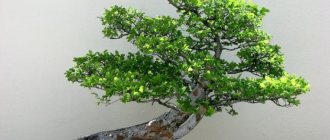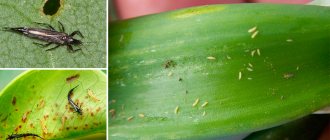Mock orange is a perennial deciduous plant, naturally distributed in America and Asia. In Russia, garden jasmine is found in the Caucasus. The culture is thermophilic with a low threshold of frost resistance. Thanks to breeding work, varieties have been created that are adapted to the weather conditions of a temperate climate. Planting and caring for mock orange in Siberia does not differ from agricultural practices in southern latitudes; the main condition is choosing a variety with high frost resistance.
Common mock orange (Philadelphus pallidus)
The species is native to Southwestern Europe. The shrub grows up to three meters in height, the foliage is large, up to eight centimeters in length, rich green on the upper side and whitish on the lower side. White flowers bloom in clusters, up to seven buds in one.
The species is frost-resistant and can easily withstand temperatures down to minus 25 degrees. Popular varieties: Virginal, Belle Etoile, Bicolor.
Popular varieties
From the foreign selection of mock orange, the following popular varieties and hybrids can be distinguished:
- Alabaster - famous for its large double fragrant snow-white flowers, collected in inflorescences up to 50 cm long. The branches of the bush are rigid, 1.5-2 m tall.
- Belle Etoile is a bicolor variety. The flowers are small, white, pink at the base, with a subtle, unobtrusive scent of jasmine. The bushes are compact.
Variety Belle Etoile
- Airborne assault - under the weight of numerous simple cream flowers, the branches of the bush droop. Strawberry aroma.
- Aurea - distinguished by bright yellow foliage. The flowers are small, solitary, cream.
- Avalanche is a medium-sized shrub with weeping branches. It blooms very profusely with white simple small flowers with a strawberry aroma.
Variety Lavina
N.V. made an invaluable contribution to the development of domestic selection of mock orange. Vekhov. The varieties bred and propagated by him decorate botanical gardens and flower gardens throughout Russia.
- Academician Komarov is a branched low bush with very large snow-white semi-double flowers with a delicate, barely perceptible aroma.
- Snow storm - the height of the bush is about 1 m. The crown is branched. The flowers are double, the inflorescences are dense. The flowers cover the bush very densely, forming a snow-white blanket.
- Pompom - small double snow-white flowers are collected in spherical inflorescences, reminiscent of pompoms in shape. The bush is compact, the aroma is weak.
Variety Pompon
- Pearls - the stems are reddish, spreading, curved, about a meter high. The flowers are snow-white, densely double.
- Gnome is a dwarf bush with a dome-shaped crown and small yellowish leaves. Doesn't bloom. Used to decorate green borders.
Lemoine mock orange (Philadelphus x lemoinei)
A hybrid species in demand among gardeners in Europe and North America. Up to three meters high, the leaves are small, it blooms in tassels, up to 7 buds in one. Popular varieties: Ermine Mantle, Schneeshturm, Glacier, Charm, Snow Storm.
Despite the fact that mock orange was previously grown in gardens much more often, now it is still very popular. The shrub has high decorative qualities and a pleasant aroma, so with proper care it will delight the gardener with its appearance and smell.
Species common in Siberia
The duration of the mock orange flowering is only a few weeks. The variety of species and bred varieties allows you to enjoy the delicate and fragrant flowers of this bush much longer due to different flowering periods.
The flowering season in Siberia opens with thin-leaved mock orange with large white, low-fragrance flowers. The height of the bush reaches 3 m. Young shoots are gray and covered with fine pubescence. The bark of adult branches is brown, often covered with cracks and peels off from the branches. Leaves are up to 10 cm long, petiolate, ovate, sometimes slightly pubescent. Thin-leaved mock orange bushes bloom in June.
Mock orange thin-leaved
Schrenk's mock orange is distinguished by its large flower size and strong aroma. Blooming in June, the bushes are covered with white flowers for almost a month. In gardening, many decorative forms of different colors and flower structures are grown.
Schrenk's mock orange
of Caucasian mock orange are widespread . Bushes of this species are tall (up to 3 m). Young shoots of the plant, painted yellow or reddish, look impressive. The flowers are pale cream, collected in long racemes of 7-10 pieces, very fragrant.
Chubushnik Caucasian
, the Venechny mock orange blooms for a month . A very persistent and common tall species. Flowers up to 4.5 cm in size, light beige, fragrant. Separately, it is worth highlighting the low-growing non-flowering form “Nana”. The height of bushes of this form reaches only half a meter.
Chubushnik Crowned
Among the low-growing species in Siberia, small-leaved mock orange , blooming at the end of June. The white flowers are solitary, have a sweet strawberry aroma and cover the thin branches with a continuous carpet. Garden forms have double and semi-double flowers with pink, white or caramel color. Cut flowering shoots remain decorative for a long time.
Chubushnik small-leaved
One of the most striking representatives of the genus in Siberian gardens is the large-flowered mock orange . The name of the species speaks for itself. The size of the flowers reaches 5 cm in diameter. Inflorescences are few-flowered (3-5 pieces). Has no smell. Flowering period is July-August.
Mock orange large-flowered
The last to bloom is the most spectacular species - Lemoine mock orange . This is a hybrid of common and small-leaved mock orange. The common mock orange (or pale mock orange) itself is not grown in Siberia due to the low threshold of frost resistance. The white, large, fragrant flowers of Ch. Lemoine bloom in July. There are many garden forms and varieties known.
Mock orange Lemoine
Planting mock orange
It is best to plant shrubs in open areas where the plant will receive plenty of sunlight. It is best to plant in the ground in the fall, at the end of September or beginning of October.
You can plant the plant in early spring, but in this case it must be done before the buds open, otherwise the likelihood that the plant will take root will be extremely low.
The distance between the bushes depends on whether the gardener plans to form a single planting or wants to create a hedge. In the first case, the distance between the bushes should be at least one meter to facilitate further plant care; in the second - about 50 centimeters.
About a week before the intended planting of mock orange, it is worth preparing planting holes approximately 60 centimeters deep. A drainage layer about 15 centimeters high is added to the bottom of the pit, then a layer of soil consisting of a mixture of earth, sand and humus mixed in a ratio of 3:2:1. After this, the hole is generously filled with water and left for at least seven days to shrink.
When the hole is completely ready, it is necessary to place the seedling in the hole so that the neck of the root is approximately level with the surface of the earth, then the hole is filled with the soil mixture described above. After this, water the plant generously and, after waiting for the soil to shrink, add dry soil on top to level the overall level.
Keep in mind that you should not allow the root neck to be too deep: if it is immersed more than 3-5 centimeters underground, there is a high probability of rotting.
Circumcision
The shrub grows quickly and erratically, requiring regular pruning. The procedure begins strictly after the start of flowering, because flowers form on shoots no younger than two years old, and excessive removal of such branches will spoil the appearance of the plant.
Branches with weak inflorescences and painful-looking branches are cut off by about a third of their length. When choosing a cut location, pay attention to the location of the upper bud. Choose a place so that the top bud is directed not to the center of the plant, but to its outer part, to prevent their growth into the bush.
Every few years it is worth carrying out thinning sanitary pruning, removing the oldest, thickest branches to rejuvenate the plant.
If you follow the simple principles stated above when pruning, then the shrub in your garden will look as attractive as in the photo of a mock orange from professional greenhouses.
Garden double jasmine
Through the efforts of breeders, several varieties of jasmine have been developed with double white flowers and a faintly perceptible odor, completely different from the usual aroma of jasmine.
Agrotechnical techniques for growing and caring for terry jasmine are basically no different from caring for conventional varieties, except that it is more difficult to tolerate frosty Russian winters. Until the bush has grown too large, it is recommended to cover it for the winter so that the plant does not freeze.
Branches of bushes that are already several years old often freeze, but spring pruning saves the situation: after removing the frozen branches, the bush continues to develop well and delight with its abundant flowering.
Know! It is better to purchase varieties of double jasmine from Russian selections; they are more adapted to cold winters.
In order to protect the root system of terry jasmine from freezing, before the onset of cold weather the ground under the bushes is covered with a thick layer of peat, pine needles, and chopped straw.
Watering and fertilizing
In the first year of life, the plant needs to be watered regularly, but older plants cope well on their own due to their developed root system.
However, during summer droughts, when the weather is hot for a long time, the plant can be helped to avoid its withering. Monitoring the condition of its leaves helps you figure out how to water a shrub.
Due to this self-sufficiency of the plant, it does not particularly need fertilizing, but to stimulate long-term flowering, it is permissible to apply universal fertilizer at the very beginning of spring.
Growing from seeds
Before planting, mock orange seeds require stratification at a temperature of +2-3ºC for two months. It is recommended to prepare a mixture of peat and sand for this, sow the seeds in a container with the mixture and place it in the refrigerator.
After two months, the seeds are planted in a mixture of peat, humus and soil in a 2:1:1 ratio, and the container is covered to create greenhouse conditions. The soil must be moistened 2-3 times a day; seedlings will appear in about a week. Seedlings are planted in open ground after they have grown stronger and formed several leaves.
It is worth considering that propagation by seeds does not guarantee the preservation of the decorative qualities of plants; seedlings can grow into a wild variety of the plant.
Price of jasmine seedlings
It is impossible to provide unambiguous information on this issue, since it will vary in different regions. It will also matter what variety of mock orange the gardener wants to purchase.
The average price for a two-year-old plant can range from 300 to 370 rubles, three-year-old seedlings are correspondingly more expensive; There are also very expensive copies. If the order is made through online stores, catalogs are provided on their pages indicating the plant variety, its age, characteristics, and price.
Propagation by cuttings
For cuttings, annual shoots are selected that can easily take root with a minimum of care. Cuttings must be treated with a root formation stimulator and then placed in a container with nutrient soil at a shallow depth.
The container with cuttings must be placed in greenhouse conditions, and the soil must be regularly sprayed to maintain constant moisture. After the formation of a strong root system, the seedlings can be planted in open ground.
Creating layering and dividing the bush
These propagation methods are less reliable than cuttings; the level of rooting of young plants formed using these methods hardly exceeds 50%.
However, if a gardener decides to propagate a plant using these methods, he should carry out the process in the same steps as with any other shrubs: mock orange does not require special conditions.
Shelter for the winter
Young plants need winter shelter. For these purposes, straw or spruce branches are used. Sometimes only snow cover is enough for wintering. To do this, the bushes are bent to the ground even before the leaves fall, since later the branches will be fragile. If snow does not completely cover the bush, it should be added until a sufficient covering layer is obtained.
Powerful mature bushes do not need shelter. Sometimes shoots can freeze slightly (especially in varieties with colored and variegated leaves). After spring pruning, they quickly recover.
Mock orange in landscape design
Pests and diseases
Mock orange is rarely affected by any diseases: the plant has strong immunity, most often the reason for the poor health of the bush is a lack or excess of moisture, or its presence in the shade in an unsuccessfully chosen place.
If a plant is affected by spotting or mold, standard treatment with fungicides helps; if harmful insects appear, treatment with insecticides according to the type of infection helps.
Mock orange can be used as an element of garden decoration, as a source of shade and a pleasant smell in the area, or even as a hedge around the perimeter of the area. The decorative properties of the mock orange plant allow you to imaginatively decorate your garden with shrubs without much effort.
Beneficial properties of jasmine flowers
This wonderful plant is able to satisfy not only the aesthetic needs of a person, it helps him maintain and improve health. Fragrant jasmine flowers are widely used in folk medicine and cooking.
Flowers are added to teas and soft drinks, flavoring them and enriching them with microelements. Japanese scientists have found that the aroma of tea with the addition of jasmine flowers has higher tonic properties than coffee aroma.
In addition, such teas have an analgesic effect and serve as a preventive measure for cardiovascular diseases.
Crushed flower petals can be added to homemade ice cream to create a delicious dessert.
